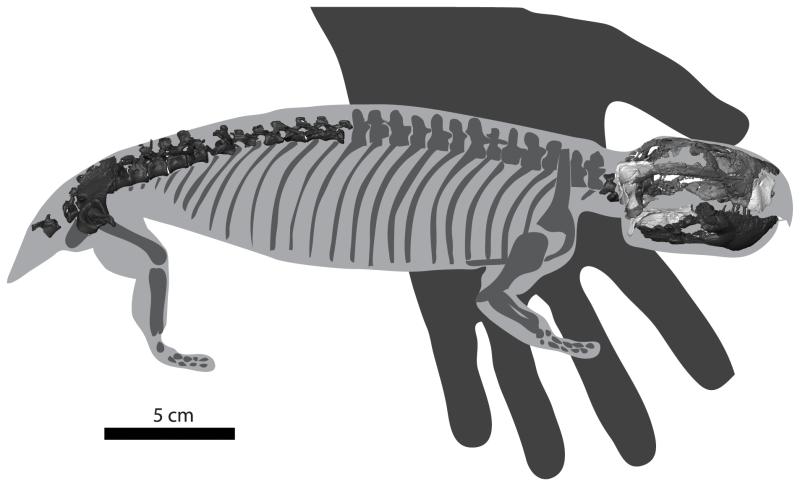In the remote province of Niassa, Mozambique, a new species and genus of fossil vertebrate was found. The species is a distant relative of living mammals and is approximately 256 million years old. This new species belongs to a group of animals called synapsids. Synapsida includes a number of extinct lineages that dominated the communities on land in the Late Permian (260-252 million years ago), as well as living mammals and their direct ancestors.
A team of paleontologists from nine institutions, including Kenneth Angielczyk, associate curator of paleomammology at Chicago’s Field Museum, described the anatomy of Niassodon in the scientific journal PLoS ONE. The fossil was named Niassodon mfumukasi, which means in the local language (Chiyao): the queen of Lake Niassa. The name is a tribute to the Yao matriarchal society, to the women of Mozambique and to the beauty of Lake Niassa.

Preserved skeletal elements of Niassodon mfumukasi (ML1620) imposed on a Pristerodon silhouette. Skeletal parts repositioned are in dark grey. Skeletal parts mirrored from the other side are in light grey. Skeletal parts in the original position are in intermediate grey. (Credit: Rui Castanhinha et al. Bringing Dicynodonts Back to Life: Paleobiology and Anatomy of a New Emydopoid Genus from the Upper Permian of Mozambique. PLoS ONE, 2013; 8 (12): e80974 DOI: 10.1371/journal.pone.0080974)
The research was conducted under the auspices of Projecto PalNiassa, an international, multidisciplinary scientific collaboration that includes more than two dozen scientists from three different continents. The goal of the project is to find, study, and preserve the paleontological heritage of Mozambique.
Niassodon mfumukasi is the first new genus (and species) of a fossil vertebrate from Mozambique, and its holotype (name-bearing specimen) is a rare example of a basal synapsid that preserves the skull and much of the skeleton together.
By using micro-computed tomography it was possible to reconstruct digitally not only the bones of Niassodon but also to build a virtual model of its brain. This reveals new information on the brain anatomy of early synapsids, which is important for understanding the evolution of many features of the mammalian brain. The reconstruction of the brain and inner ear anatomy developed for Niassodon is the most detailed presented to date for an early synapsid. Using the digital data acquired in the tomographies, it was possible to isolate all individual bones preserved which allowed the researchers to create a new topological color code, codified mathematically, for the cranial bones. This code will allow the researchers to standardize the colors used in similar digital model built for other animals. The fossil can be visited in the Lourinhã Museum (Portugal), but soon will return to Mozambique, where it will become part of the collections of the National Museum of Geology in Maputo.
The specimen was collected during fieldwork in 2009 with the support of National Museum of Geology (Maputo) and was prepared at the Lourinhã Museum (Portugal), Instituto Gulbenkian de Ciência (Oeiras, Portugal) and Southern Methodist University (Dallas); the 3D tomography was performed in DESY-HZG (Hamburg, Germany). This project was sponsored by Fundação Calouste Gulbenkian, the National Geographic Society, and TAP Portugal.



 December 5th, 2013
December 5th, 2013  Riffin
Riffin  Posted in
Posted in  Tags:
Tags: 